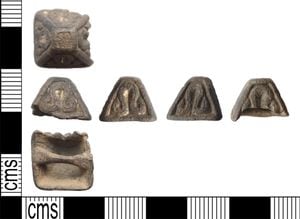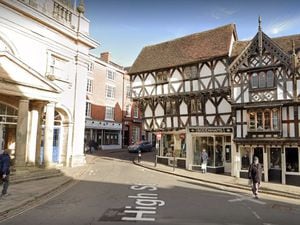Anglo-Saxon silver mount found in south Shropshire is treasure
An early medieval silver mount found in south Shropshire, which dates back to the sixth century, has been declared treasure.

The complete cast gilded silver pyramidal mount was discovered in the parish of Culmington, between Craven Arms and Ludlow, and was declared treasure at an inquest by coroner John Ellery.
Mr Ellery told the inquest on Tuesday that the find was reported to the Portable Antiquities Scheme in December, after being found by Frank Healing who was out metal detecting in the area.
The metal mount would probably have been used to help secure a sword into its scabbard in Anglo-Saxon times.
Lydia Prosser, finds liaison officer for Lancashire and Cumbria, prepared a report for the coroner which described the artefact in detail.
It said: “The mount is complete, being a four-sided pyramid with a flat, square top.
“Each face is decorated with an inverted U-shape motif, the terminals of which curl back upon themselves.
“The motif is in shallow relief and set within a recessed panel.
“The mount is hollow with a square base. An integral bar runs centrally across the underside of the mount and this is how the mount would have been affixed to a scabbard.
“Traces of gilding are retained in the recessed areas; otherwise, the mount is dark grey in colour. In size it is around 14mm square and rises to a height of 9mm. It weighs 2.65 grams.”
Uncertain
The report from the Portable Antiquities Scheme also states that the mounts are “well known in Anglo-Saxon and Continental archaeological contexts”.
Reading the report, Mr Ellery said: “Their function is still uncertain, but it seems likely that they were used to help secure the sword in the scabbard, by means of a strap running through the transverse bar on the base.
“Two were famously found in the high-status graves of Sutton Hoo Mound 1, but they are relatively uncommon grave finds. They are, however, familiar as stray finds with ever-increasing numbers recorded on the PAS database.
“Close parallels decorated with the inverted U-shaped motif are recorded from West Lindsey, Lincolnshire; Drax, North Yorkshire – topped with a garnet – and Newbold Pacey, Warwickshire.”
He explained that the item dates back to the mid sixth to early seventh century and contains a minimum of 10 per cent precious mental.
Mr Ellery found that the find was more than 300 years old when discovered and formed of precious metal – silver, with a content of more than 10 per cent – with this in mind he declared the item treasure under the 1996 Act.





